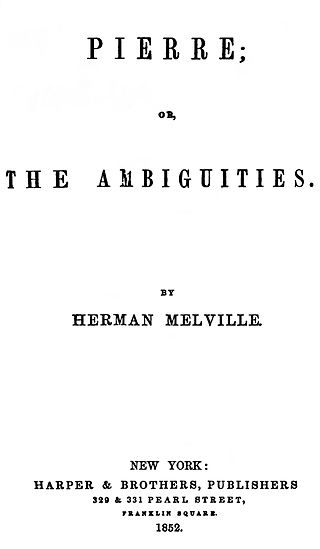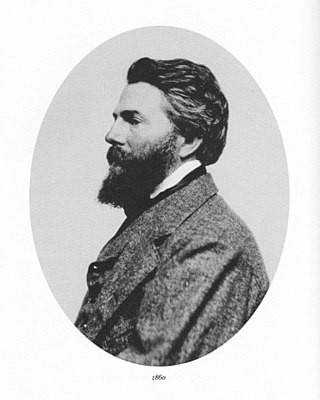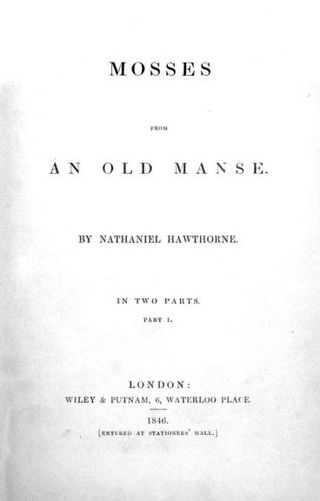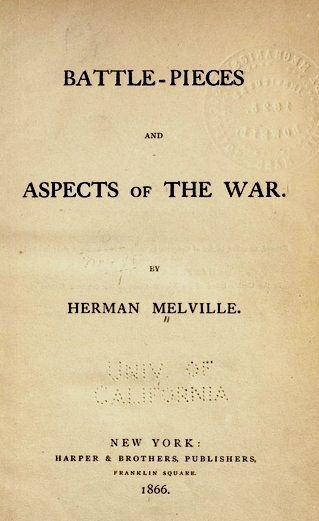Related Research Articles

Herman Melville was an American novelist, short story writer, and poet of the American Renaissance period. Among his best-known works are Moby-Dick (1851); Typee (1846), a romanticized account of his experiences in Polynesia; and Billy Budd, Sailor, a posthumously published novella. At the time of his death, Melville was no longer well known to the public, but the 1919 centennial of his birth was the starting point of a Melville revival. Moby-Dick eventually would be considered one of the great American novels.

Moby-Dick; or, The Whale is an 1851 novel by American writer Herman Melville. The book is the sailor Ishmael's narrative of the maniacal quest of Ahab, captain of the whaling ship Pequod, for vengeance against Moby Dick, the giant white sperm whale that bit off his leg on the ship's previous voyage. A contribution to the literature of the American Renaissance, Moby-Dick was published to mixed reviews, was a commercial failure, and was out of print at the time of the author's death in 1891. Its reputation as a Great American Novel was established only in the 20th century, after the 1919 centennial of its author's birth. William Faulkner said he wished he had written the book himself, and D. H. Lawrence called it "one of the strangest and most wonderful books in the world" and "the greatest book of the sea ever written". Its opening sentence, "Call me Ishmael", is among world literature's most famous.

Billy Budd, Sailor , also known as Billy Budd, Foretopman, is a novella by American writer Herman Melville, left unfinished at his death in 1891. Acclaimed by critics as a masterpiece when a hastily transcribed version was finally published in 1924, it quickly took its place as a classic second only to Moby-Dick among Melville's works. Billy Budd is a "handsome sailor" who strikes and inadvertently kills his false accuser, Master-at-arms John Claggart. The ship's Captain, Edward Vere, recognizes Billy's lack of intent, but claims that the law of mutiny requires him to sentence Billy to be hanged.
"Bartleby, the Scrivener: A Story of Wall Street" is a short story by the American writer Herman Melville, first serialized anonymously in two parts in the November and December 1853 issues of Putnam's Magazine and reprinted with minor textual alterations in his The Piazza Tales in 1856. In the story, a Wall Street lawyer hires a new clerk who, after an initial bout of hard work, refuses to make copies or do any other task required of him, refusing with the words "I would prefer not to."

White-Jacket; or, The World in a Man-of-War is the fifth book by American writer Herman Melville, first published in London in 1850. The book is based on the author's fourteen months' service in the United States Navy, aboard the frigate USS Neversink.

Pierre; or, The Ambiguities is the seventh book by American writer Herman Melville, first published in New York in 1852. The novel, which uses many conventions of Gothic fiction, develops the psychological, sexual, and family tensions between Pierre Glendinning; his widowed mother; Glendinning Stanley, his cousin; Lucy Tartan, his fiancée; and Isabel Banford, who is revealed to be his half-sister. According to scholar Henry A. Murray, in writing Pierre Melville "purposed to write his spiritual autobiography in the form of a novel" rather than to experiment and incidentally work some personal experience into the novel.

Benito Cereno is a novella by Herman Melville, a fictionalized account about the revolt on a Spanish slave ship captained by Don Benito Cereno, first published in three installments in Putnam's Monthly in 1855. The tale, slightly revised, was included in his short story collection The Piazza Tales that appeared in May 1856. According to scholar Merton M. Sealts Jr., the story is "an oblique comment on those prevailing attitudes toward blacks and slavery in the United States that would ultimately precipitate civil war between North and South". The famous question of what had cast such a shadow upon Cereno was used by American author Ralph Ellison as an epigraph to his 1952 novel Invisible Man, excluding Cereno's answer, "The negro." Over time, Melville's story has been "increasingly recognized as among his greatest achievements".
The Piazza Tales is a collection of six short stories by American writer Herman Melville, published by Dix & Edwards in the United States in May 1856 and in Britain in June. Except for the newly written title story, "The Piazza," all of the stories had appeared in Putnam's Monthly between 1853 and 1855. The collection includes what have long been regarded as three of Melville's most important achievements in the genre of short fiction, "Bartleby, the Scrivener", "Benito Cereno", and "The Encantadas", his sketches of the Galápagos Islands.

Northwestern University Press is an American publishing house affiliated with Northwestern University in Evanston, Illinois. It publishes 70 new titles each year in the areas of continental philosophy, poetry, Slavic and German literary criticism, Chicago regional studies, African American intellectual history, theater and performance studies, and fiction. Parneshia Jones is director of the press. It is a member of the Association of University Presses.
"The Encantadas, or Enchanted Isles", is a novella by American author Herman Melville. First published in Putnam's Magazine in 1854, it consists of eleven philosophical "Sketches" on the Galápagos Islands, then frequently known as the "Enchanted Islands" from the treatcherous winds and currents around them. It was collected in The Piazza Tales in 1856. The Encantadas was a success with the critics and contains some of Melville's "most memorable prose".
"Isle of the Cross" is a possible unpublished and lost work by Herman Melville, which would have been his eighth book, coming after the commercial and critical failures of Moby-Dick (1851) and Pierre: or, The Ambiguities (1852). Melville biographer Hershel Parker suggests that the work, perhaps a novel, perhaps a story, was what had been known as the "story of Agatha," completed around May 1853. He further suggests that finishing the work showed that Melville had not, as many biographers argued, been discouraged and turned away from fiction.
Hershel Parker is an American professor of English and literature, noted for his research into the works of Herman Melville. Parker is the H. Fletcher Brown Professor Emeritus at the University of Delaware. He is co-editor with Harrison Hayford of the Norton Critical Edition of Herman Melville's Moby-Dick, and the General Editor of the Northwestern-Newberry Edition of The Writings of Herman Melville, which, with the publication of volume 13, "Billy Budd, Sailor" and Other Uncompleted Writings, is now (2017) complete in fifteen volumes. Parker is the author of a two-volume biography of Herman Melville published by Johns Hopkins University Press. Parker also edited the first ever one-volume edition of Melville's complete poetry, Herman Melville: Complete Poems, published by the Library of America in 2019.

The bibliography of Herman Melville includes magazine articles, book reviews, other occasional writings, and 15 books. Of these, seven books were published between 1846 and 1853, seven more between 1853 and 1891, and one in 1924. Melville was 26 when his first book was published, and his last book was not released until 33 years after his death. At the time of his death he was on the verge of completing the manuscript for his first novel in three decades, Billy Budd, and had accumulated several large folders of unpublished verse.

"Hawthorne and His Mosses" (1850) is an essay and critical review by Herman Melville of the short story collection Mosses from an Old Manse written by Nathaniel Hawthorne in 1846. Published pseudonymously by "a Virginian spending July in Vermont", it appeared in The Literary World magazine in two issues: August 17 and August 24, 1850. It has been called the "most famous literary manifesto of the American nineteenth century."
The Melville Society is an organization for the study of author Herman Melville. Founded in 1945, the Society was a result of the Melville Revival of the 1920s and 1930s and is now the oldest American society devoted to a single literary figure.
Merton M. Sealts Jr. was a scholar of American literature, focusing on Ralph Waldo Emerson and Herman Melville. His most important works are the genetic edition of Melville's Billy Budd, Sailor, Pursuing Melville, 1940–1980 (1982) and Melville's Reading. He taught at Lawrence College (1948–1965), and became Henry A. Pochmann Professor of English at the University of Wisconsin–Madison (1965-1982). He won both Ford Foundation and Guggenheim fellowships.
George Thomas Tanselle is an American textual critic, bibliographer, and book collector, especially known for his work on Herman Melville. He was Vice President of the John Simon Guggenheim Foundation from 1978 to 2006.

Battle-Pieces and Aspects of the War is the first book of poetry of the American author Herman Melville. Published by Harper & Brothers of New York in 1866, the volume is dedicated "To the Memory of the Three Hundred Thousand Who in the War For the Maintenance of the Union Fell Devotedly Under the Flag of Their Fathers" and its 72 poems deal with the battles and personalities of the American Civil War and their aftermath. Also included are Notes and a Supplement in prose in which Melville sets forth his thoughts on how the Post-war Reconstruction should be carried out.
John Marr and Other Sailors is a volume of poetry published by Herman Melville in 1888. Melville published twenty-five copies at his own expense, indicating that they were intended for family and friends. Henry Chapin wrote in an introduction to a reprint that "Melville's loveable freshness of personality is everywhere in evidence, in the voice of a true poet".
Walter E. Bezanson was a scholar and critic of American literature best known for his studies of Herman Melville and contributions to the Melville revival that restored the writer to prominence in the 1940s and 1950s. Bezanson's research and editorial work rescued from neglect Mevlille's unappreciated epic poem, Clarel, and he published essays on Moby-Dick that were widely cited and reprinted.
References
- Bryant, John (2006). "Melville's Prisoners (Review)". Leviathan. 8 (2): 98–94. doi:10.1353/lvn.2006.0027 (inactive 31 January 2024).
{{cite journal}}: CS1 maint: DOI inactive as of January 2024 (link) - Cotkin, George (2012). Dive Deeper: Journeys with Moby-Dick. New York: Oxford University Press. ISBN 9780199855735.
- Fritz, Meaghan (November 22, 2017), "The Coiled Fish of the Sea": A Brief History of the Northwestern-Newberry Edition of the Writings of Herman Melville", Incidental Noyes, Northwestern University Press.
- Gilgenbach, Cara, and College of Wooster. Women's Studies Program (1993). Catalogue and Reference Guide to "The Josephine Long Wishart Collection: Mother, Home, and Heaven". Wooster, Ohio: College of Wooster.
{{cite book}}: CS1 maint: multiple names: authors list (link) - Students (2003). "Harrison Hayford (1916–2001): His Students Recollect". Leviathan. 5 (1): 71–86. doi:10.1111/j.1750-1849.2003.tb00071.x.. Short reminiscences by Tanselle, G. Thomas, Hershel Parker, Amy Puett Emmers, William G. Holzberger, Joel Myerson, Russell Reising, Robert D. Madison, Mary K. Bercaw Edwards, Alma Macdougall Reising and Steven Olsen-Smith.
- Honan, William (20 December 2001), "Harrison Mosher Hayford, 85, Professor and Melville Expert", New York Times
- McLellan, Dennis (23 December 2001), "Harrison Hayford, 85; Professor, Top Expert on Herman Melville", Los Angeles Times
- Parker, Hershel (1990), Reading Billy Budd, Evanston, IL: Northwestern University Press, ISBN 978-0-8101-0961-2
- Sandlin, Lee (28 May 1982), reprinted Lee Sandlin.com, "The Man Who Edited Melville", Chicago Reader
- Spark, Clare L. (2006). Hunting Captain Ahab : Psychological Warfare and the Melville Revival. Kent, Ohio: Kent State Univ. Press. ISBN 978-0-87338-888-7.
- Tanselle, G. Thomas (1986), "Melville and the World of Books", A Companion to Melville Studies, John Bryant, ed, New York: Greenwood Press